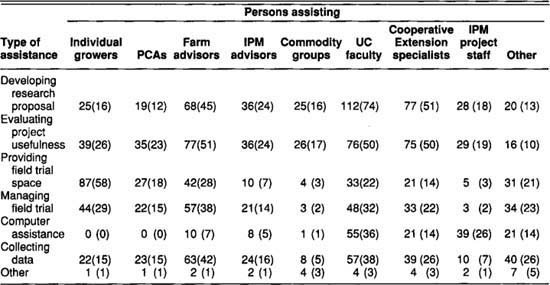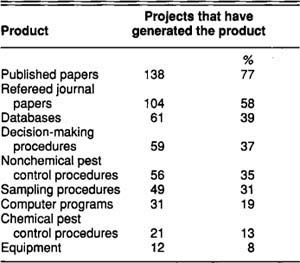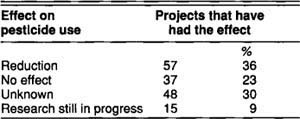All Issues
IPM Research results: Statewide IPM's first 10 years
Publication Information
California Agriculture 44(5):24-26.
Published September 01, 1990
PDF | Citation | Permissions
Abstract
An independent review of research funded by UC IPM in its first ten years provides evidence of a successful program with practical impact on pest management practices. The review also suggests that some research projects have led to reductions in pesticide use.
Full text
Frank Zalom, Director of the IPM Implementation Group, places a pheromone attractant into a codling moth trap. Moths drawn by the scent are caught on the trap's sticky inner surface.
Since 1979, the University of California's Statewide Integrated Pest Management Project has addressed pest management problems through a combination of research and education. Integrated pest management (IPM) stresses ecologically and economically sound practices for the control of agriculture control of agricultural pests. IPM practices include biological, cultural, and mechanical control, as well as the judicious, reduced use of chemical pesticides.
The IPM Project was created by the California legislature, partly as a response to apparent agricultural production problems and to growing public pressure for alternatives to pesticide use. The project also builds bridges between academic specialties (e.g., entomology, plant pathology, nematology, plant sciences, etc.) by supporting interdisciplinary research and development efforts that can lead to a more balanced approach to pest management. In ten years, the IPM Project has allocated over $7.1 million, or 46% of its total budget, to 180 research projects.
The project's tenth anniversary is an appropriate time for evaluating its operation, accomplishments, and impacts. Ideally, such an evaluation would use multiple review and assessment methods to sketch an accurate portrait. As a first step in this evaluation, in 1989 we undertook an independent review of program-funded research. Our intent was to assess the program's effectiveness in promoting practical, interdisciplinary, goal-oriented research from the perspective of the researchers.
Method
Between 1979 and 1988, 180 research projects received funding from the Statewide IPM Project. These projects were conducted by 229 principal investigators (PIs), so several projects must have been managed by multiple PIs. A number of researchers received funds for multiple projects. After we identified the PIs, we sent each a previously field-tested questionnaire for each funded project. The original questionnaire was sent in August, 1989; if no completed survey was received within three weeks, we sent a reminder letter. A few PIs were contacted by telephone or in person for their response. The questionnaire requested specific information about the interdisciplinary nature of their research (Who assisted you in the research and implementation processes?); any useful products or information produced (Were any products such as databases, sampling equipment, sampling procedures, or nonchemical pest control measures developed through this research?); and field use of those results (Have the information or products developed in this research been used in-field by growers or pest control advisors?). We also requested information on published papers written as a result of a funded project, including journal and popular press articles.
TABLE 2. Distribution of IPM projects according to the principal investigators' academic specialization
Response rates
We received completed, usable survey forms from 167 (73%) of the 229 listed principal investigators. One hundred sixty-two, or 90% of all 180 funded projects were represented in those responses. Comparisons on the basis of commodity and academic specialty between the total number of funded proposals and those represented by at least one survey response indicated that individuals responding were representative of all PIs (table 1, table 2, and table 3). Responses were compiled and tabulated by the authors, neither of whom was affiliated with the Statewide IPM Project.
Before 1986, IPM research efforts had emphasized a narrow commodity focus: alfalfa, citrus, tomatoes, cotton, rice, grapes, walnuts, and cereals. In 1986, the research emphasis was expanded to cut across commodity lines. Thereafter, research proposals were evaluated on the basis of pest management strategy: cultural controls, biological controls, monitoring systems, systems application, and commodity-pest interactions rather than on the basis of commodity. This change substantially increased the range of commodity-based projects as well as the number of cross-commodity projects funded by the program (table 1).
Interdisciplinary bridges
Most research projects (68%) were managed by two or more researchers. Nearly two out of five projects involved researchers from two different agricultural disciplines (38%) and two or more institutions (36%) (table 2 and table 3). These results suggest, at least superficially, that the IPM Project was successful in fostering and generating interdisciplinary research. While the management of projects by investigators from different academic specializations may not guarantee the “ecological systems approach to pest management research” (as outlined in the 1979 IPM Annual Report), activities by interdisciplinary management teams suggest coordination and cooperation across traditional research boundaries.
Researchers reported receiving assistance from a variety of sources. Most commonly, PIs were assisted by other university faculty, Cooperative Extension Specialists, and Farm Advisors. Over half of all investigators (51%) had Farm Advisors help them evaluate the practical usefulness of their proposed research, and 65% of the projects' investigators indicated that Farm Advisors helped them implement their results as field practice (table 4). Individual growers were reported as important contributors to IPM research. Growers provided field trial space for 58% of the projects, and evaluated one out of five projects (26%) for practical utility. Organized commodity groups cooperated with researchers in 28% of all projects to help the investigators implement their research activities. According to these findings, most funded proposals were researched and implemented with interdisciplinary and multi-level approaches that went beyond the specializations of the principal investigators.
TABLE 4. Number of projects receiving various types of assistance from various types of person (n - 150, percentages are in parentheses).
Research outcomes
The IPM research projects have generated “products” to be used for pest management. These products include in-field pest management strategies, monitoring systems, and equipment. They also include publications of various types to disseminate research-based pest management information.
Ninety-one percent of reporting projects claimed to have developed identifiable products. Products ranged from improved nonchemical pest control procedures to improved sampling methods, and from more effective decision-making procedures (e.g., action thresholds) to new pest monitoring equipment (table 5). In all, PI responses indicated that 148 of the 162 projects led to development of one or more products, a result that suggests the UC IPM goal for “practical, goal-oriented research” was addressed and probably achieved.
More than 75% (125) of the projects resulted in some type of publication, including 104 refereed journal articles. Other publications included popular press articles, Cooperative Extension publications, and book chapters. As of the end of 1989,578 publications based on project-funded research had been produced.
Principal investigators also reported that such products as sampling and pest control procedures were in use in the field. Based on PI responses, about 43% of the funded research resulted in pest management products or information that is now being used by growers and pest control advisers (PCAs) (table 6). Besides field application, funded research has reportedly led to further pest management studies and research (54%) and to subsequent non-program funding for continued research (32%).
Effect on pesticide use
An important question was whether research had contributed to the IPM goal of reducing the agricultural use of pesticides. Principal investigators were asked if they had any evidence that their research had resulted in a reduction in pesticide use. Thirty-six percent of all projects' PIs responded that they did have evidence of such pesticide reduction (table 7). In the questionnaire, we made no effort to document the nature or the validity of evidence, and the respondents' claims have not been verified. This result is intriguing and potentially significant. Moreover, it provides great incentive for the detailed study of the projects claiming to have reduced the use of chemical pesticides.
Discussion
This study gives important but preliminary evidence that the research efforts of the UC IPM program have led to numerous and significant results. Taken together, the responses of the PIs validate the effectiveness of a research grant allocation program that has succeeded in facilitating applied, problem-solving research. Funded proposals have resulted in many usable and used products. In a surprisingly large number of cases, IPM research may have led to reductions in pesticide use. The research program has led to the development of pest management information, equipment, and procedures that have been applied in the field, of publications, and of continued research activities. The research program has also involved Cooperative Extension Farm Advisors, growers, commodity groups, and pest control advisers in organized research activities.
Our conclusions are preliminary. Since our means for collecting information were limited to the questionnaire and our review of IPM Annual Reports, results have to be dealt with carefully. The validity of PI responses is an open question. This study also raises many questions that merit further investigation. For example: What is the connection between Farm Advisor or PCA involvement and the nature of in-field pest management practices? What evidence is there to indicate that pesticide reductions result from IPM research? To what degree are research-based “products” actually used, and how wide-spread is their use? Are products developed 10 years ago in wider use today than those developed 5 years ago? These are among the questions that can be included in future studies.
Nevertheless, the results of this review should help UC IPM staff and advisory committees evaluate their effectiveness in supporting research that meets the project's original mandates. The results can also be used to modify the grant allocation process by identifying research proposals that are most likely to meet project emphasis on rapid, practical field implementation.













